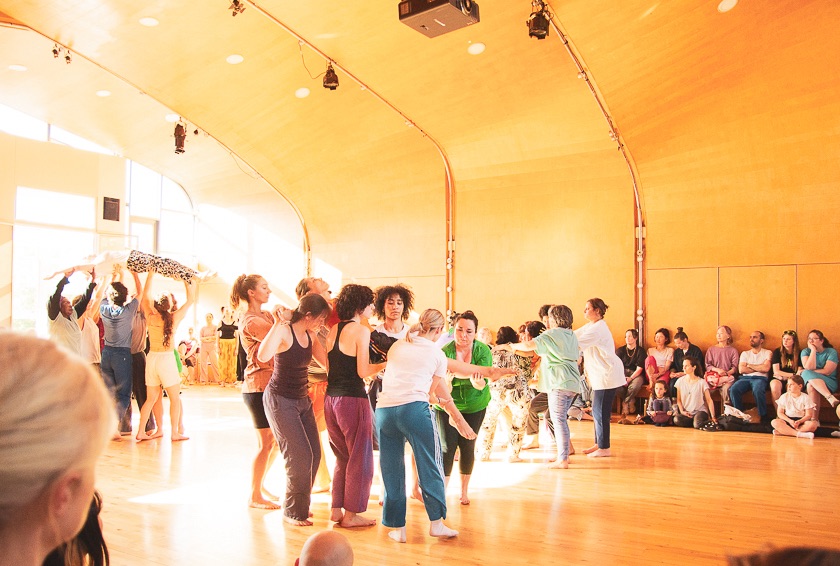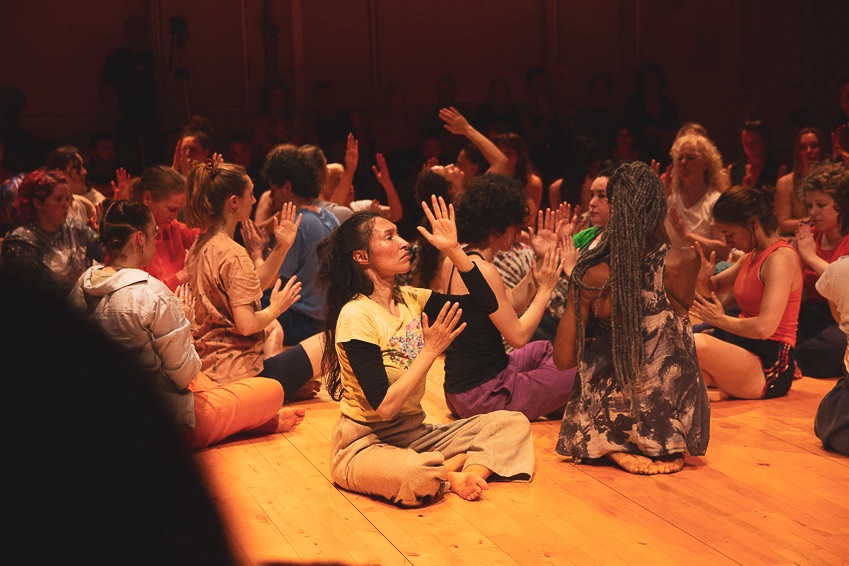Words by Paula Catalina Riofrio.
In bocca al lupo! answered one of the participants when I asked her how to say good luck in her mother tongue. In bocca al lupo (its English translation is inside the wolf’s mouth) is the best way to invite you into this article. It makes a perfect connection to what FEAR at Siobhan Davies Studios was: a celebration of collective power towards an experience, a reflection, a panning perspective upon the future and the unknown.
Co-Artistic Directors Kat Bridge and Annie Pui Ling Lok have brought a visionary proposal to develop four community projects at Siobhan Davies Studios. FEAR and its past performance projects Language in 2022 and Power in 2023 share a transversal line of questioning hierarchical ways of working, moving, speaking and performing. The idea of making a collective performance for all ages, abilities and backgrounds came into life because of the need to create a more intentional happening inside the building. Kat and Annie wanted to extend an explicit yet intimate invitation for people to come, meet each other and create inside the studio.
My pages would run short to describe Siobhan Davies Studios, but if I could only have a couple of words those would be: inclusivity, experimentation and community.
I originally joined FEAR as a participant and attended FEAR’s free workshops over the course of two weeks. I was also invited to write about the project’s final performance on 22nd June by my editor who didn’t know I was part of the project. And so this review I’m sharing is kind of an experiment. In my review I reflect on what it was like to be part of a project with more than 40 performers and collaborators, a prolific sound designer, Nikki Crowley, and four ingenious directors Annie, Anne-Gaelle Thiriot, Juan Ayala and Anna Alvarez.
The process
The past is referenced as something that is left behind us, whereas the future has always been seen as movement forward. During the first session we were invited to twist this preconception the other way around; seeing present and past in front of us, whilst stepping backwards into the future to come. Walking became a process where there was no beginning and no ending. I thought of my body as the arrow of Zenon’s paradox.
The room was filled with strangers that were drawn into the same direction for the sake of creating. Some of them were dancers, some of them filmmakers, sculptors, teachers, mothers, children, critics, ketchup lovers; there was space for all of us.
On our first Saturday together we had a tango lesson during the first hour and a guided transformation into animals during the second one. Nikki accompanied us with abstract, dilated rhythms and echoing wolf howls. Later Nikki started merging music in different languages, raising and lowering the tempo. My mind was quiet so my body could listen and travel through those changes.
Sessions were unusual, as were the methods for choreographing. I learned from Juan that a parody of the UK Migratory Form could turn into a performative rave and that later it could be turned into poignant tableaus.
Over the course of the second week, Anne-Gaelle helped us centre ourselves in calmness with Feldenkrais exercises, some of them were included in the show. Parts of the choreography played with ambiguity; most of the movements were selected because of their multiple interpretations. I believe the intention was to overlap ideas with clear gestures and let the meaning of them reverberate.
Days run short to meet everyone, but at a certain point I stopped looking into the name tags that we wore and directly spoke to their faces. Practising the wolf howling felt like the coming together of individuals. The couple-dancing sequence became a space of trust instead of a negotiation of power between leaders and followers. The block sequence reached a quality of pantomimic politeness, just like Annie had envisioned. Sadness was there, somewhere between the gaps, but hope was pouring out stronger than ever, fluid as our sweat.
I stepped out during the last rehearsal. I saw each participant’s personality imprinted on their faces. I saw dialogues among the scenes. I watched them unleash their energy and watched it fluctuate inside the room. I saw it in the bodies; there was something poignant but also celebratory, perhaps the coming together into the chaos and its soft intimate and circular resolution. I left the studio joyful, looking at the sky wondering what my agency is within fear? How is it different to encounter fear alone?
The celebration
Juan said ¡Mucha mierda! to me and to other Spanish speakers before the show. Merde! I gesture to a couple of friends. Nathan, one of the youngest participants, entered the stage and headed straight into the middle. The rest of us gathered around him and started shaking. You could feel synchronised steps, synchronised heartbeats.
The performance was serious, enigmatic and distorted by the soundscape. It was divided into three loops. We transformed into wolves; we turned into angels, guiding people who were walking backwards and lifting up the bodies that needed to be lifted. We screamed, we contracted our faces, we laid our heads against each other. When I stepped out to watch them I could see the quality of their movement; personal, intimate, solid. Their hands showed the concentration that they lived in and out of themselves.

The performers are the work, the fear and its transformation. There was a movement where we brushed our partner’s spine with our head, then we had to come out from in-between their legs. On the day of the show it felt like a ritual for renewal. The final loop had started and the curtains were dripping down. The most vivid image I have now is the memory of the mesmerising eyes of my dance partner; open, still, a mirror to my eyes. After that we started walking backwards, three steps, two steps, one over and over. Lights went off, people cheered and whistled. Nikki put her music back on, contagious beats. The audience started wiggling towards the stage and joined us for a short rave. Crepi il lupo.
This article was commissioned by SDS.
